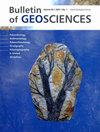来自埃及开罗-苏伊士地区中新世中下沉积序列的钙质管状覆壳多毛类
IF 1.5
3区 地球科学
Q3 GEOSCIENCES, MULTIDISCIPLINARY
引用次数: 1
摘要
(例如Gosselin & Sewell 2013)从二叠纪(Sanfilippo et al. 2017)到现在(例如Rouse & Pleijel 2001)。大多数建管多毛类蠕虫是底栖和静止的悬浮食性蠕虫(例如Díaz-Castañeda & Reish 2009)。蛇形钙质管在整个侏罗纪和白垩纪到全新世期间表现出快速的多样化(Jäger 1983, 2004, 2012, 2014;伊波利托夫,2007a, b, 2010;Sklenář et al. 2013;Ippolitov et al. 2014;Kočí & Ledvák 2014;Kočí et al. 2017)。它们分泌并栖息在一个永久的钙质管中,这个管可以附着在生物和无机的硬基质上。它们最常被发现为死后结块(例如Garberoglio & Lazo 2011, Sklenář et al. 2013, El- sabbagh & El Hedeny 2016, El- sabbagh et al. 2016, veselsk本文章由计算机程序翻译,如有差异,请以英文原文为准。
Calcareous tube-dwelling encrusting polychaetes from a lower-middle Miocene sedimentary succession, Cairo-Suez District, Egypt
(e.g. Gosselin & Sewell 2013) from the Permian (Sanfilippo et al. 2017) to the present day (e.g. Rouse & Pleijel 2001). Most tube-building polychaete worms are benthic and sedentary suspension feeders (e.g. Díaz-Castañeda & Reish 2009). Serpulid-like calcareous tubes displayed a rapid diversification throughout the Jurassic and Cretaceous until the Holocene (Jäger 1983, 2004, 2012, 2014; Ippolitov 2007a, b, 2010; Sklenář et al. 2013; Ippolitov et al. 2014; Kočí & Ledvák 2014; Kočí et al. 2017). They secrete and inhabit a permanent calcareous tube that can be attached to both biogenic and inorganic hard substrates. They are most commonly found as post-mortem encrusters (e.g. Garberoglio & Lazo 2011, Sklenář et al. 2013, El-Sabbagh & El Hedeny 2016, El-Sabbagh et al. 2016, Veselská et al. 2021) but may also be colonizers of living hosts (in vivo; e.g. El Hedeny et al. 2021). Hard substrates in the modern oceans are often heavily encrusted by polychaetes. They are common in all marine settings, ranging from the intertidal down to hadal depths (e.g. Hill 2013, Ippolitov et al. 2014). In addition, they were important encrusting organisms in the geological past (e.g. El-Sabbagh & El Hedeny 2016, El-Sabbagh et al. 2016). Hence, the study of ancient representatives could provide information on palaeoecology and palaeoenvironment. Sediments of the lower‒middle Miocene succession exposed in the Cairo-Suez District yield a significant polychaete assemblage, which, together with bivalves (oysters, pectinids and others), gastropods and echinoids, constitute the characteristic fossil assemblage in that area. Other common fossils include corals and bryozoans. So far, little attention has been paid to fossil calcareous tubedwelling encrusting polychaetes in Egypt (e.g. El-Sabbagh & El Hedeny 2016, El-Sabbagh et al. 2016). Therefore, this
求助全文
通过发布文献求助,成功后即可免费获取论文全文。
去求助
来源期刊

Bulletin of Geosciences
地学-地球科学综合
CiteScore
3.10
自引率
5.30%
发文量
18
审稿时长
>12 weeks
期刊介绍:
The Bulletin of Geosciences is an international journal publishing original research papers, review articles, and short contributions concerning palaeoenvironmental geology, including palaeontology, stratigraphy, sedimentology, palaeogeography, palaeoecology, palaeoclimatology, geochemistry, mineralogy, geophysics, and related fields. All papers are subject to international peer review, and acceptance is based on quality alone.
 求助内容:
求助内容: 应助结果提醒方式:
应助结果提醒方式:


